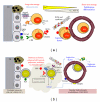Osteoblastic and vascular endothelial niches, their control on normal hematopoietic stem cells, and their consequences on the development of leukemia
- PMID: 22190963
- PMCID: PMC3236318
- DOI: 10.4061/2011/375857
Osteoblastic and vascular endothelial niches, their control on normal hematopoietic stem cells, and their consequences on the development of leukemia
Abstract
Stem cell self-renewal is regulated by intrinsic mechanisms and extrinsic signals mediated via specialized microenvironments called "niches." The best-characterized stem cell is the hematopoietic stem cell (HSC). Self-renewal and differentiation ability of HSC are regulated by two major elements: endosteal and vascular regulatory elements. The osteoblastic niche localized at the inner surface of the bone cavity might serve as a reservoir for long-term HSC storage in a quiescent state. Whereas the vascular niche, which consists of sinusoidal endothelial cell lining blood vessel, provides an environment for short-term HSC proliferation and differentiation. Both niches act together to maintain hematopoietic homeostasis. In this paper, we provide some principles applying to the hematopoietic niches, which will be useful in the study and understanding of other stem cell niches. We will discuss altered microenvironment signaling leading to myeloid lineage disease. And finally, we will review some data on the development of acute myeloid leukemia from a subpopulation called leukemia-initiating cells (LIC), and we will discuss on the emerging evidences supporting the influence of the microenvironment on chemotherapy resistance.
Figures

References
-
- Orford KW, Scadden DT. Deconstructing stem cell self-renewal: genetic insights into cell-cycle regulation. Nature Reviews Genetics. 2008;9(2):115–128. - PubMed
-
- Schofield R. The relationship between the spleen colony-forming cell and the haemopoietic stem cell. A hypothesis. Blood Cells. 1978;4(1-2):7–25. - PubMed
-
- Purton LE, Scadden DT. Limiting factors in murine hematopoietic stem cell assays. Cell Stem Cell. 2007;1(3):263–270. - PubMed
-
- Perry JM, Li L. Disrupting the stem cell Niche: good seeds in bad soil. Cell. 2007;129(6):1045–1047. - PubMed
-
- Patt HM, Maloney MA. Bone marrow regeneration after local injury: a review. Experimental Hematology. 1975;3(2):135–148. - PubMed
LinkOut - more resources
Full Text Sources

